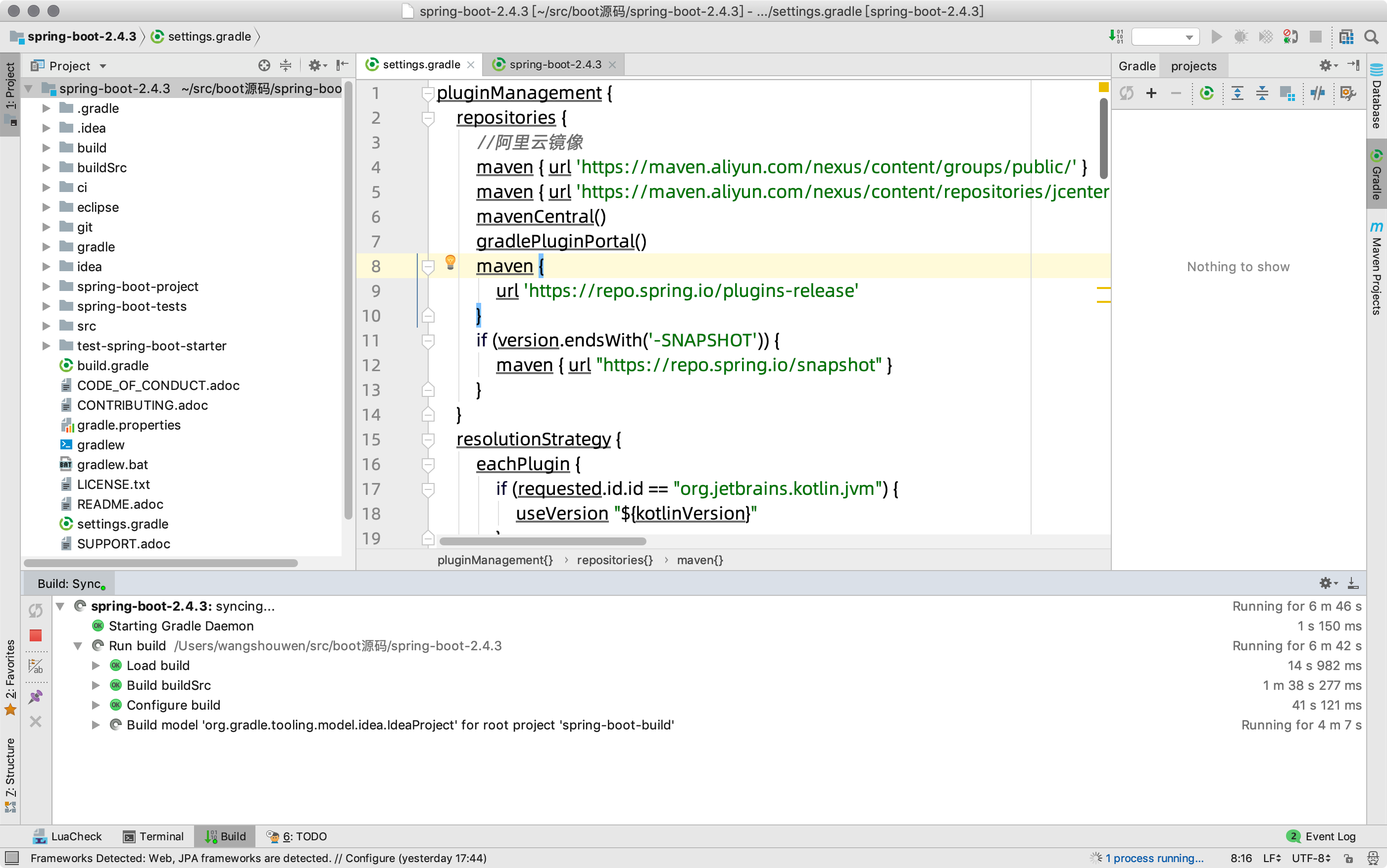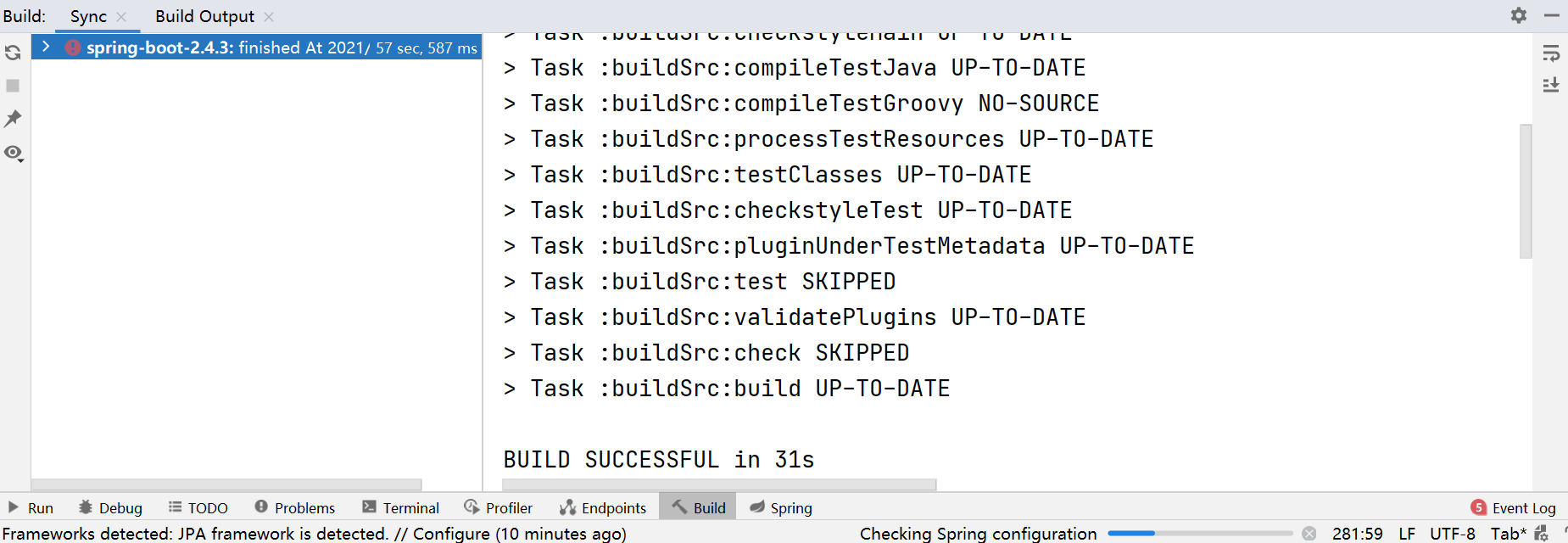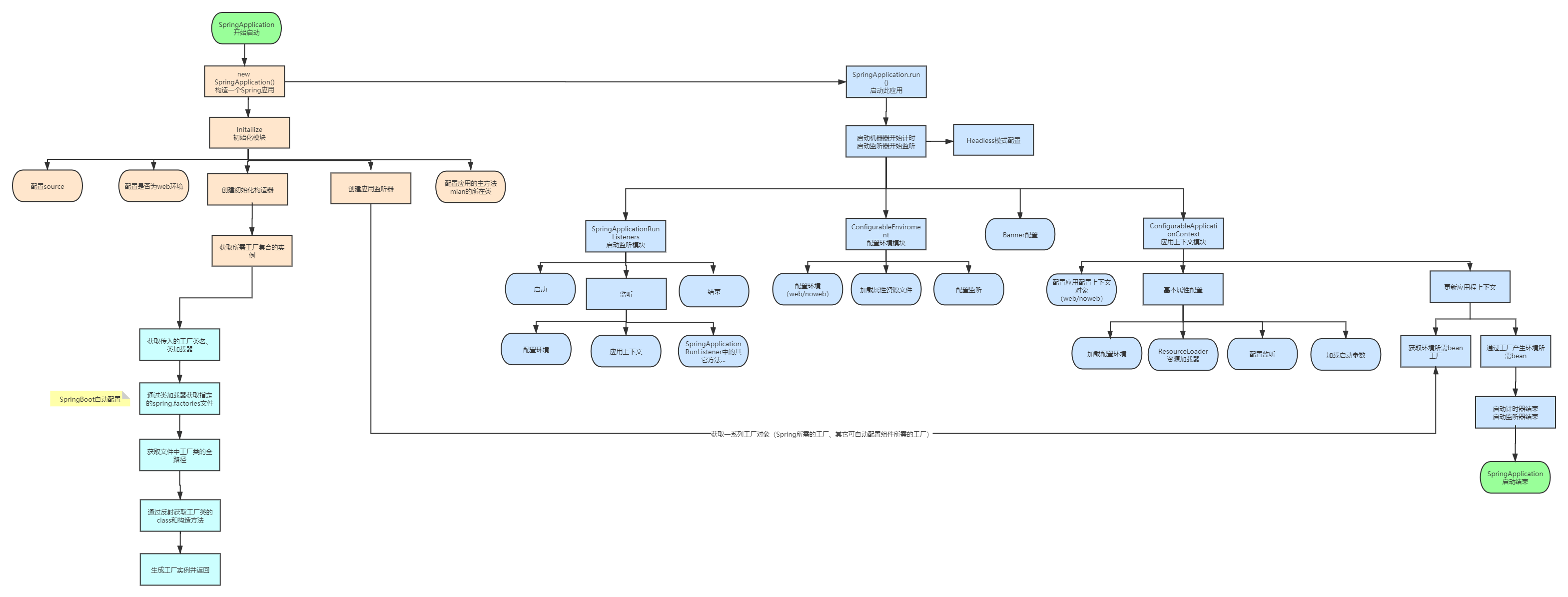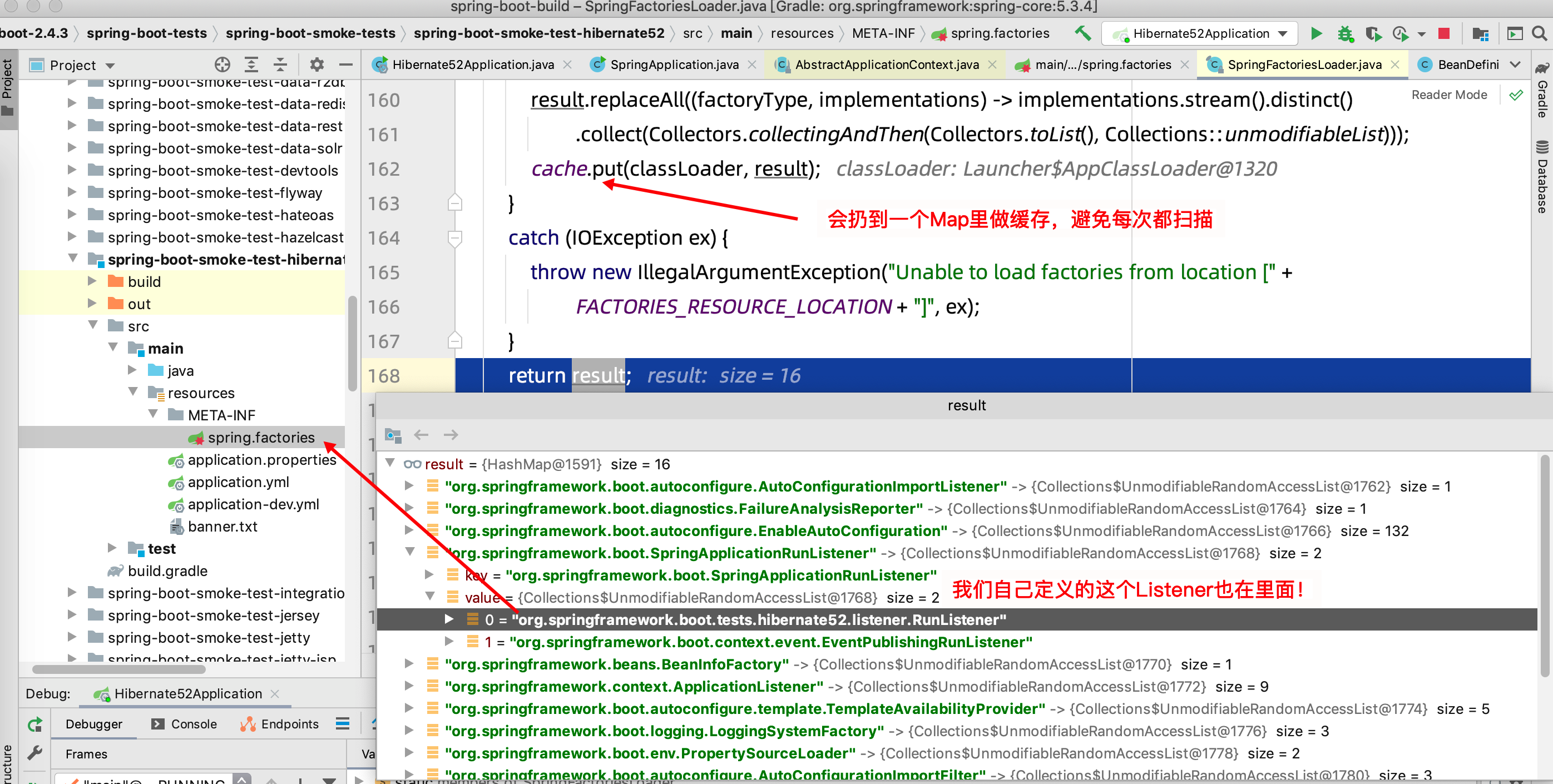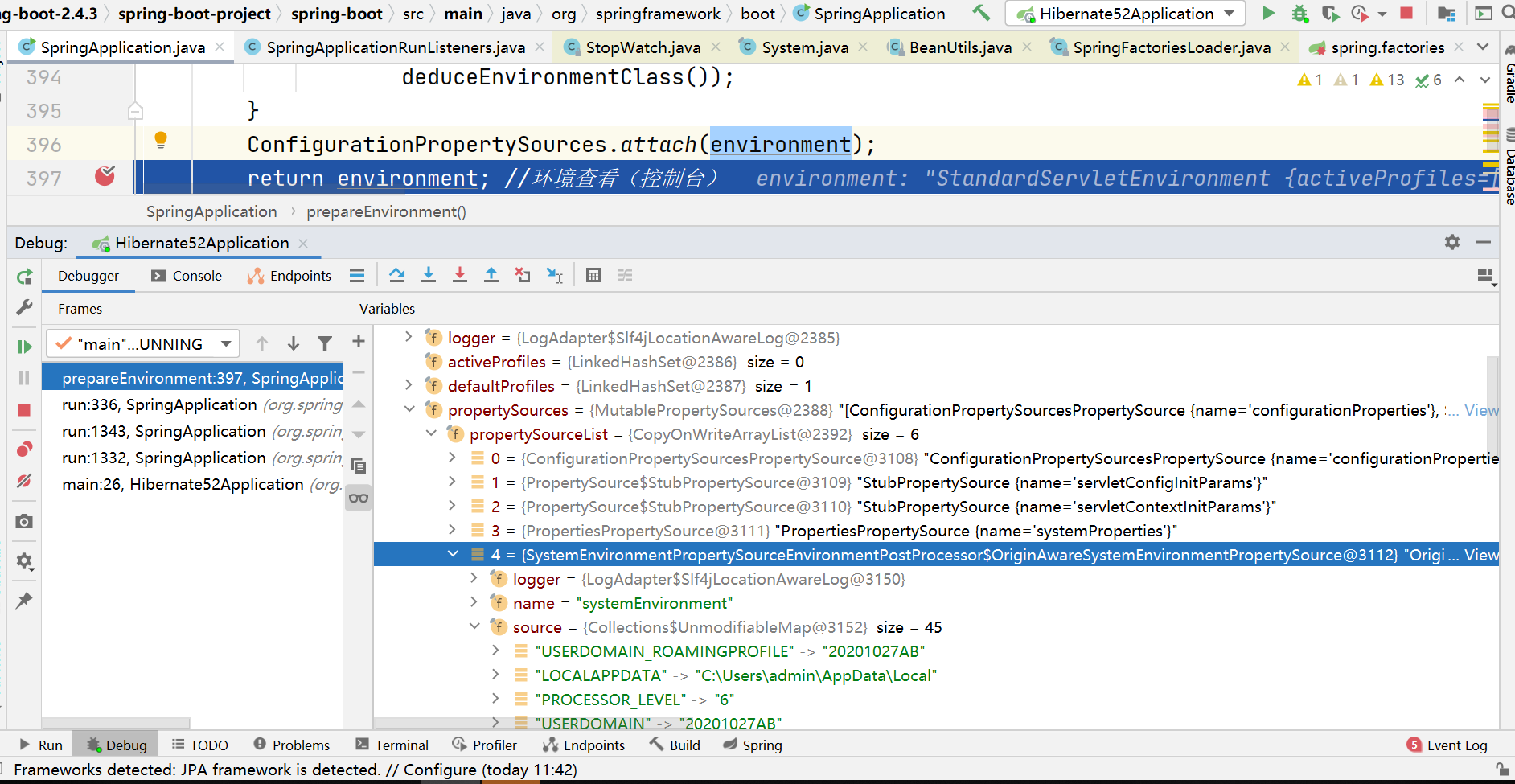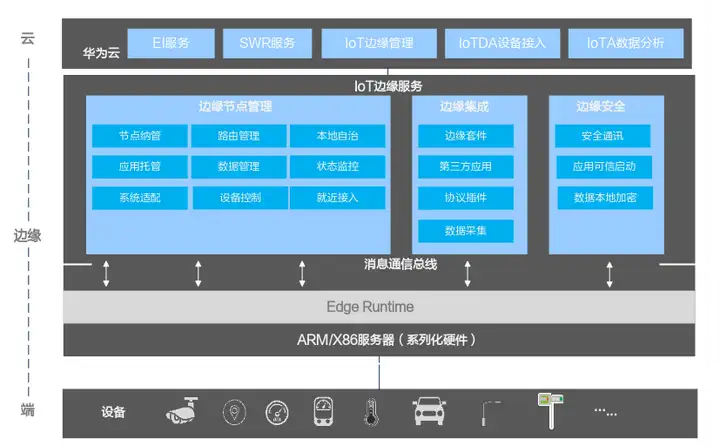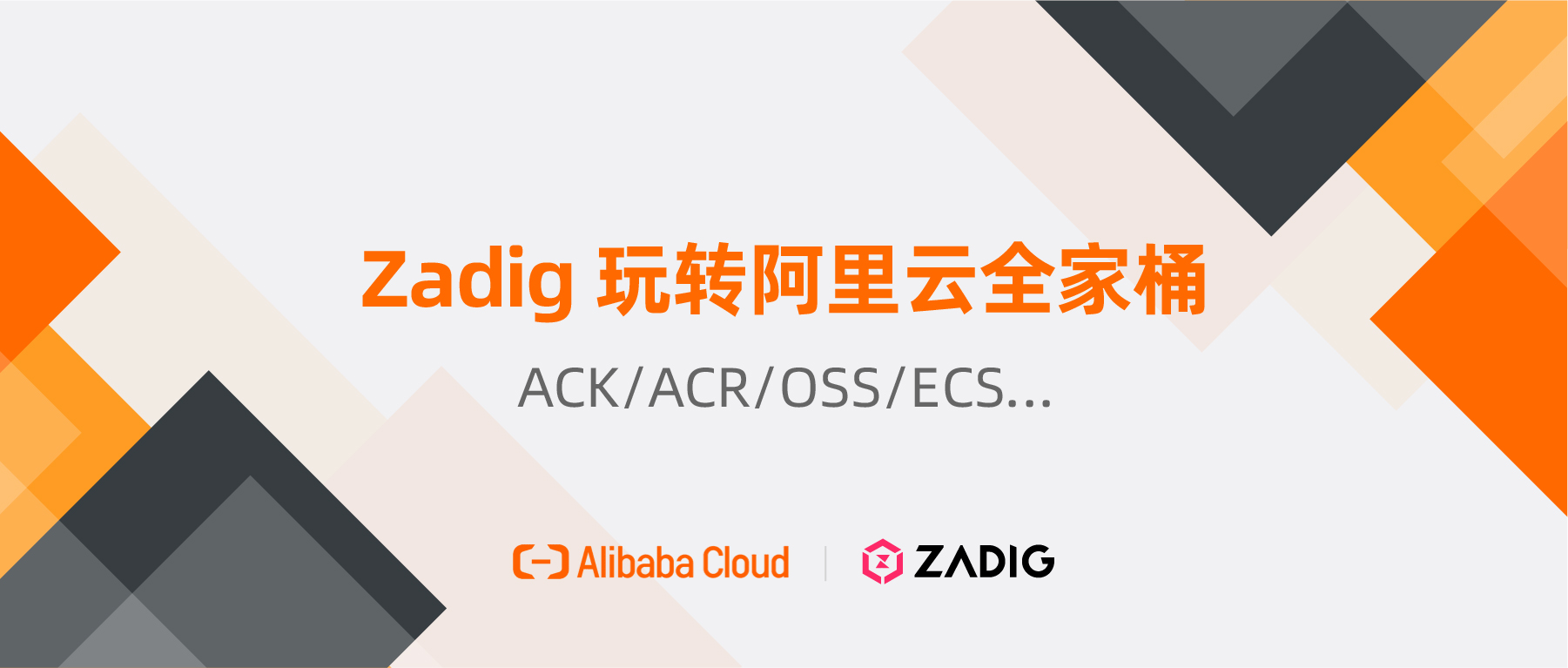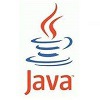给她讲最爱的SpringBoot源码
1 Spring boot源码环境构建
推荐环境:
idea:2020.3
gradle:版本gradle-6.5.1
jdk:1.8
注意!idea和gradle的版本有兼容性问题,要注意搭配
1.1 Spring boot源码下载
1、从github获取源码,网址:
https://github.com/spring-projects/spring-boot
我们要搭建的是2.4.3.RELEASE版本,所以点击release 之后在tags查找相应版本或者访问
https://github.com/spring-projects/spring-boot/releases/tag/v2.4.3
找到 后点击sourcecode下载源码压缩包
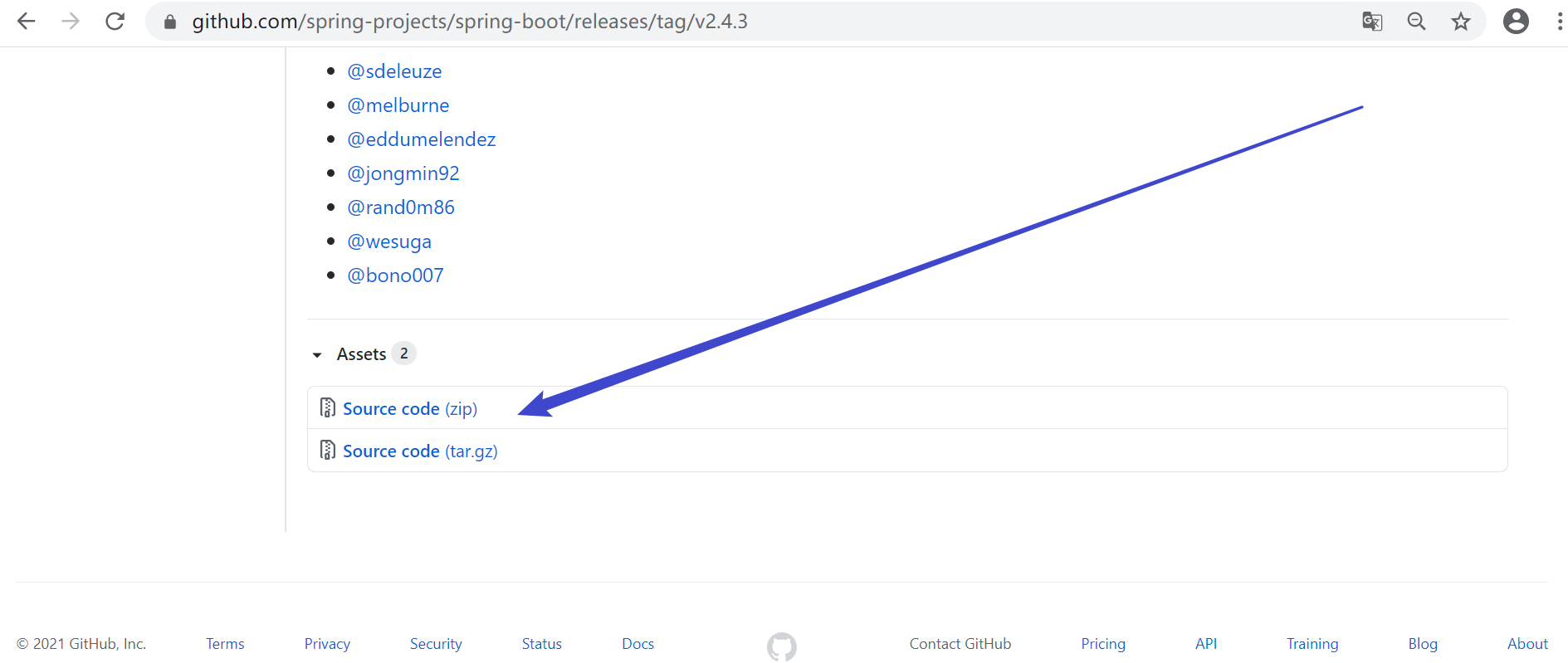
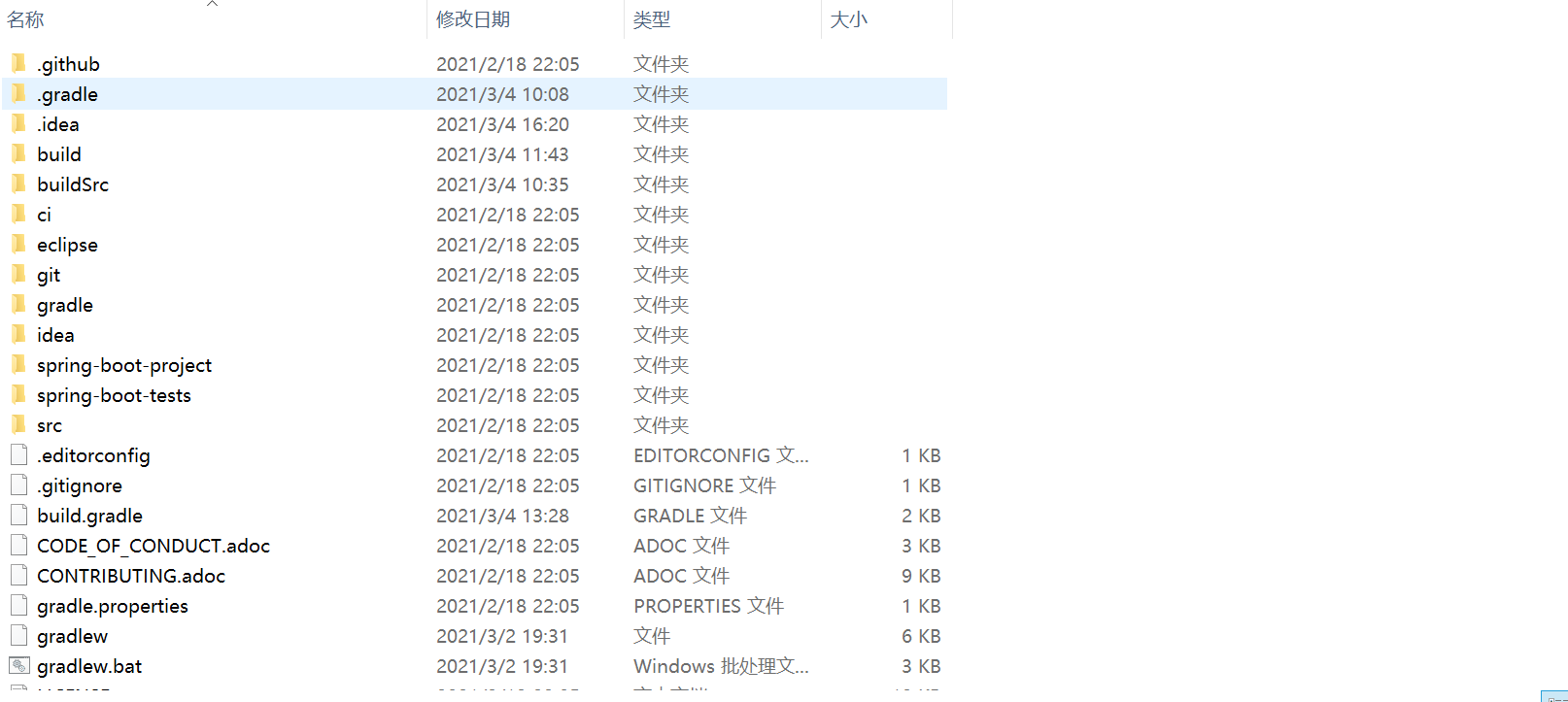
2、直接用提供的源码包(推荐)
将源码导入到idea。漫长的等待……
1.2 Spring boot源码编译
1、环境配置
推荐配置:
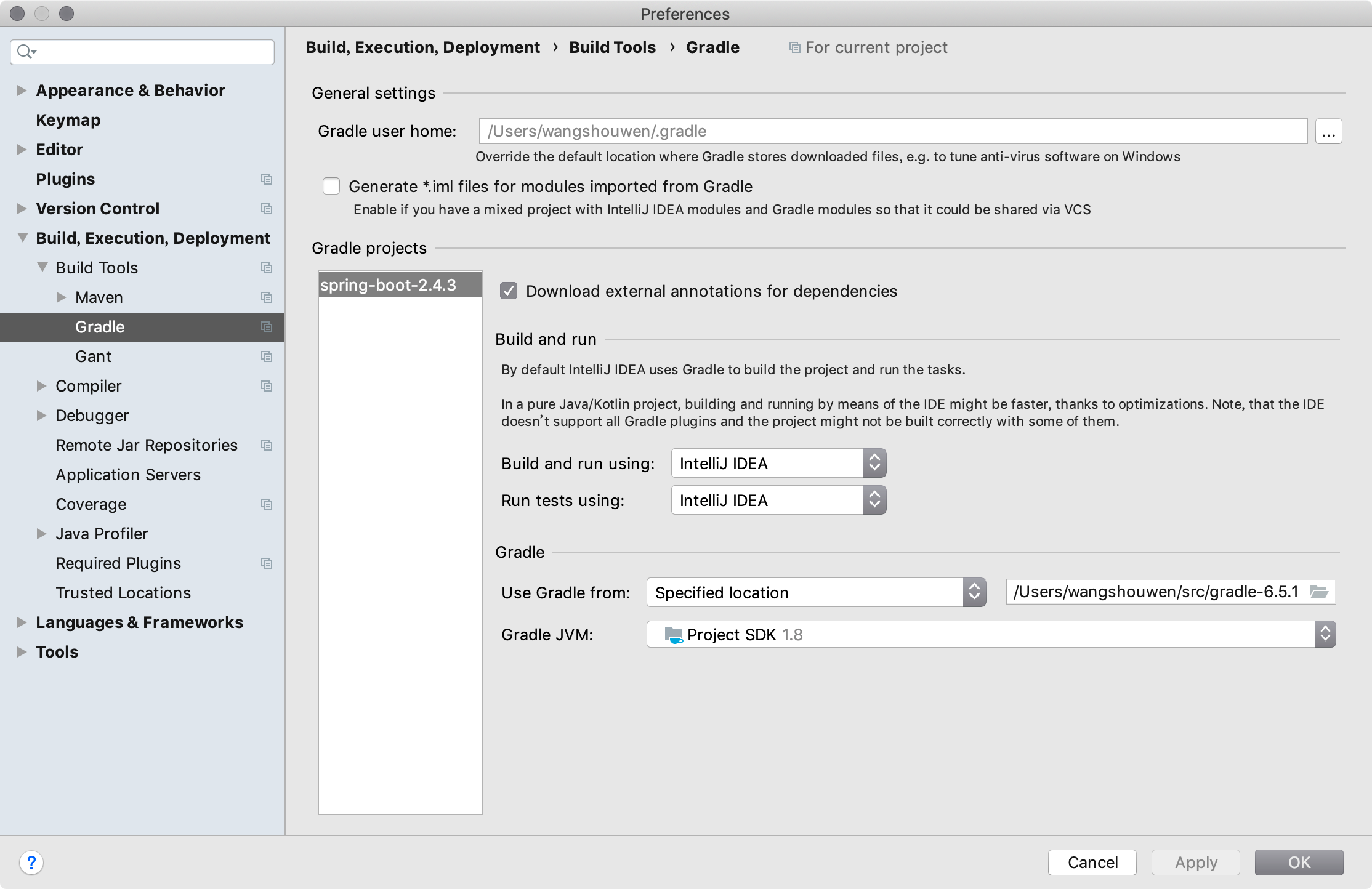
使用idea的build,不要用gradle的任务
看到下面的BUILE SUCESSFUL表示成功
1.3 Spring boot冒烟测试
在springboot-boot-tests模块下很多冒烟测试的,会拖慢上面的编译,只留下了一个:
spring-boot-smoke-test-hibernate52工程来进行冒烟测试,打开Hibernate52Application.java文件,直接执行main方法启动springboot,成功!
org.springframework.boot.tests.hibernate52.Hibernate52Application
package org.springframework.boot.tests.hibernate52;
import org.springframework.boot.SpringApplication;
import org.springframework.boot.autoconfigure.SpringBootApplication;
@SpringBootApplication
public class Hibernate52Application {
public static void main(String[] args) {
SpringApplication.run(Hibernate52Application.class, args);
}
}
执行run
console中出现我们熟悉的图标。
2 Spring boot源码深度剖析
引言
使用过SpringBoot开发项目的读者应该都能够感觉到
SpringBoot的开发完成后,只需要通过执行一个main方法就可以将整个web项目启动
无需将项目的jar文件放在tomcat下,然后启动tomcat,进而启动项目。
除此之外,好多依赖的jar包也无需我们再进行手动配置,减少了配置,
同时也减少了许多xml文件的配置,大大简化了我们的开发过程
那么
springboot在启动的时候到底做了哪些事情?
2.1 Spring boot启动流程剖析
第一步:new SpringApplication(primarySources)
第二步:run!
2.1.1 Spring boot启动流程剖析
Debug一下,追踪一下整个启动过程
main方法作为程序的入口,执行SpringApplication.run(),传入参数是启动类的class对象
1)Spring boot源码入口
@SpringBootApplication
public class Hibernate52Application {
public static void main(String[] args) {
SpringApplication.run(Hibernate52Application.class, args);
}
}
跟踪run方法;进入到
参数一可支持多个主要资源。
public static ConfigurableApplicationContext run(Class<?> primarySource, String... args) {
return run(new Class<?>[] { primarySource }, args);
}
继续进入到run方法
public static ConfigurableApplicationContext run(Class<?>[] primarySources, String[] args) {
return new SpringApplication(primarySources).run(args);
}
2)构造器(new)
//方法目标
//1、初始化资源加载器(classloader)
//2、处理primarySources
//3、web应用类型推断 (web、reactive、servlet)
//4、通过spring.factories加载配置类并初始化监听器 (SPI) 【重点】
//5、提取主类
public SpringApplication(ResourceLoader resourceLoader, Class<?>... primarySources) {
//null;资源加载器,用来获取 Resource 和 classLoader 以及加载资源
this.resourceLoader = resourceLoader;
Assert.notNull(primarySources, "PrimarySources must not be null");
//存放主加载类;set中可同时创建多个Application,最后要解析这个来源上的注解
this.primarySources = new LinkedHashSet<>(Arrays.asList(primarySources));
//推断 web 类型:servlet 或 reactive
this.webApplicationType = WebApplicationType.deduceFromClasspath();
// 0个,从spring.factories中找出Bootstrapper对应的属性
this.bootstrappers = new ArrayList<>(getSpringFactoriesInstances(Bootstrapper.class));
// 7个,设置初始化器,从spring.factories中找出ApplicationContextInitializer对应的属性
setInitializers((Collection) getSpringFactoriesInstances(ApplicationContextInitializer.class));
// 9个,设置监听器 从spring.factories中找出ApplicationListener对应的属性
setListeners((Collection) getSpringFactoriesInstances(ApplicationListener.class));
//找出主函数main的类
this.mainApplicationClass = deduceMainApplicationClass();
}
上面 的代码最终会调用到getSpringFactoriesInstances,从spring.factories加载属性配置
加载核心源码如下
下面代码
首先会用classLoader加载类路径下的所有spring.factories的配置内容,loadSpringFactories方法将返回一个key=接口名,value=实现类集合的Map结构
private static Map<String, List<String>> loadSpringFactories(ClassLoader classLoader) {
// 先试着取缓存
Map<String, List<String>> result = cache.get(classLoader);
if (result != null) {
return result;
}
result = new HashMap<>();
try {
// 获取所有spring.factories的URL(3个地方)
Enumeration<URL> urls = classLoader.getResources(FACTORIES_RESOURCE_LOCATION);
// 遍历URL
while (urls.hasMoreElements()) {
URL url = urls.nextElement();
UrlResource resource = new UrlResource(url);
// 加载每个URL中的properties配置
Properties properties = PropertiesLoaderUtils.loadProperties(resource);
for (Map.Entry<?, ?> entry : properties.entrySet()) {
String factoryTypeName = ((String) entry.getKey()).trim();
// 将实现类的配置按照","符号分割开
String[] factoryImplementationNames =
StringUtils.commaDelimitedListToStringArray((String) entry.getValue());
for (String factoryImplementationName : factoryImplementationNames) {
// 逐个添加到接口对应的集合当中
result.computeIfAbsent(factoryTypeName, key -> new ArrayList<>())
.add(factoryImplementationName.trim());
}
}
}
// Replace all lists with unmodifiable lists containing unique elements
result.replaceAll((factoryType, implementations) -> implementations.stream().distinct()
.collect(Collectors.collectingAndThen(Collectors.toList(), Collections::unmodifiableList)));
//加入缓存
cache.put(classLoader, result);
}
catch (IOException ex) {
throw new IllegalArgumentException("Unable to load factories from location [" +
FACTORIES_RESOURCE_LOCATION + "]", ex);
}
return result;
}
主要的spring.factories
spring-boot-2.4.3/spring-boot-project/spring-boot-autoconfigure/build/resources/main/META-INF/spring.factories
spring-boot-2.4.3/spring-boot-project/spring-boot/build/resources/main/META-INF/spring.factories
spring-beans-5.3.4.jar!/META-INF/spring.factories
构造器流程总结
1、处理资源加载器、主要资源primarySources
2、web应用类型推断
3、从spring.factories中找出引导包装器、初始化器、监听器
4、设置应用程序主类
3)boot运行(run)
发布事件
打印banner
初始化ioc容器,启动tomcat
七大步骤
//七大步骤
public ConfigurableApplicationContext run(String... args) {
//计时器
StopWatch stopWatch = new StopWatch();
stopWatch.start(); //开始计时
// 创建启动上下文对象
DefaultBootstrapContext bootstrapContext = createBootstrapContext();
// 可配置的程序容器
ConfigurableApplicationContext context = null;
// 设置属性 不重要
configureHeadlessProperty();
// 第一步:获取并启动监听器 从spring.factories文件中加载【测试点】
SpringApplicationRunListeners listeners = getRunListeners(args);
//监听器发布ApplicationStartingEvent 事件.
listeners.starting(bootstrapContext, this.mainApplicationClass);
try {
// 对参数进行包装(ApplicationArguments)
ApplicationArguments applicationArguments = new DefaultApplicationArguments(args);
//第二步:准备应用程序环境【关键点】
ConfigurableEnvironment environment = prepareEnvironment(listeners, bootstrapContext, applicationArguments);
// 配置忽略bean的信息(不重要)
configureIgnoreBeanInfo(environment);
//第三步: 打印banner(可自定义,参考讲义)【关键点】
Banner printedBanner = printBanner(environment);
// 第四步:创建spring容器
context = createApplicationContext();
context.setApplicationStartup(this.applicationStartup);
//第五步:准备 applicationContext
prepareContext(bootstrapContext, context, environment, listeners, applicationArguments, printedBanner);
//第六步:ioc的refresh创建容器,初始化bean,tomcat也在这里被启动起来 【关键点】
refreshContext(context);
//第七步:上下文刷新后触发(空方法)
afterRefresh(context, applicationArguments);
stopWatch.stop();//停止计时
if (this.logStartupInfo) {
new StartupInfoLogger(this.mainApplicationClass).logStarted(getApplicationLog(), stopWatch);
}
// 发布started事件
listeners.started(context);
//执行runner的run方法 【测试点】
callRunners(context, applicationArguments);
} catch (Throwable ex) {
// 异常处理
handleRunFailure(context, ex, listeners);
throw new IllegalStateException(ex);
}
try {
// 触发running事件
listeners.running(context);
} catch (Throwable ex) {
handleRunFailure(context, ex, null);
throw new IllegalStateException(ex);
}
// 返回最终构建的容器对象
return context;
}
2.1.2 Spring boot七大步骤详解
1)获取并启动监听器
这里的启动监听就是我们需要监听SpringBoot的启动流程监听,实现SpringApplicationRunListener类即可监听
//获取spring.factories中 key为SpringApplicationRunListener的对象实例。
private SpringApplicationRunListeners getRunListeners(String[] args) {
Class<?>[] types = new Class<?>[]{SpringApplication.class, String[].class};
// 通过从 spring.factories 中获取 SpringApplicationRunListener 类型的配置类
return new SpringApplicationRunListeners(logger,
getSpringFactoriesInstances(SpringApplicationRunListener.class, types, this, args),
this.applicationStartup);
}
查看具体SpringApplicationRunListener都有哪些方法
package org.springframework.boot;
import org.springframework.context.ApplicationContext;
import org.springframework.context.ConfigurableApplicationContext;
import org.springframework.core.env.ConfigurableEnvironment;
import org.springframework.core.io.support.SpringFactoriesLoader;
public interface SpringApplicationRunListener {
/**
* Called immediately when the run method has first started. Can be used for very
* early initialization.
* @param bootstrapContext the bootstrap context
*/
//当调用run方法后会立即调用,可以用于非常早期的初始化
default void starting(ConfigurableBootstrapContext bootstrapContext) {
starting();
}
/**
* Called immediately when the run method has first started. Can be used for very
* early initialization.
* @deprecated since 2.4.0 in favor of {@link #starting(ConfigurableBootstrapContext)}
*/
@Deprecated
default void starting() {
}
/**
* Called once the environment has been prepared, but before the
* {@link ApplicationContext} has been created.
* @param bootstrapContext the bootstrap context
* @param environment the environment
*/
//环境准备好之后调用
default void environmentPrepared(ConfigurableBootstrapContext bootstrapContext,
ConfigurableEnvironment environment) {
environmentPrepared(environment);
}
/**
* Called once the environment has been prepared, but before the
* {@link ApplicationContext} has been created.
* @param environment the environment
* @deprecated since 2.4.0 in favor of
* {@link #environmentPrepared(ConfigurableBootstrapContext, ConfigurableEnvironment)}
*/
@Deprecated
default void environmentPrepared(ConfigurableEnvironment environment) {
}
/**
* Called once the {@link ApplicationContext} has been created and prepared, but
* before sources have been loaded.
* @param context the application context
*/
//在加载资源之前,ApplicationContex准备好之后调用
default void contextPrepared(ConfigurableApplicationContext context) {
}
/**
* Called once the application context has been loaded but before it has been
* refreshed.
* @param context the application context
*/
//在加载应用程序上下文但在其刷新之前调用
default void contextLoaded(ConfigurableApplicationContext context) {
}
/**
* The context has been refreshed and the application has started but
* {@link CommandLineRunner CommandLineRunners} and {@link ApplicationRunner
* ApplicationRunners} have not been called.
* @param context the application context.
* @since 2.0.0
*/
/**
* 上下文已经刷新且应用程序已启动且所有{@link CommandLineRunner commandLineRunner}
* 和{@link ApplicationRunner ApplicationRunners}未调用之前调用
*/
default void started(ConfigurableApplicationContext context) {
}
/**
* Called immediately before the run method finishes, when the application context has
* been refreshed and all {@link CommandLineRunner CommandLineRunners} and
* {@link ApplicationRunner ApplicationRunners} have been called.
* @param context the application context.
* @since 2.0.0
*/
/**
* 当应用程序上下文被刷新并且所有{@link CommandLineRunner commandLineRunner}
* 和{@link ApplicationRunner ApplicationRunners}都已被调用时,在run方法结束之前立即调用。
*/
default void running(ConfigurableApplicationContext context) {
}
/**
* Called when a failure occurs when running the application.
* @param context the application context or {@code null} if a failure occurred before
* the context was created
* @param exception the failure
* @since 2.0.0
*/
//在启动过程发生失败时调用
default void failed(ConfigurableApplicationContext context, Throwable exception) {
}
}
2)准备应用程序环境
创建并配置SpringBooty应用将要使用的Environment
//不看细节,看返回的环境数据即可
//创建并配置SpringBooty应用将要使用的Environment
//过程如下:
// 1、创建配置环境 ConfigurableEnvironment
// 2、加载属性文件资源
// 3、配置监听
private ConfigurableEnvironment prepareEnvironment(SpringApplicationRunListeners listeners,
DefaultBootstrapContext bootstrapContext, ApplicationArguments applicationArguments) {
// 根据不同的web类型创建不同实现的Environment对象
ConfigurableEnvironment environment = getOrCreateEnvironment();
// 配置环境
configureEnvironment(environment, applicationArguments.getSourceArgs());
ConfigurationPropertySources.attach(environment);
// 发送环境已准备完成事件
listeners.environmentPrepared(bootstrapContext, environment);
DefaultPropertiesPropertySource.moveToEnd(environment);
// 根据命令行参数中spring.profiles.active属性配置Environment对象中的activeProfile(比如dev、prod、test)
configureAdditionalProfiles(environment);
// 绑定环境中spring.main属性绑定到SpringApplication对象中
bindToSpringApplication(environment);
// 如果用户使用spring.main.web-application-type属性手动设置了webApplicationType
if (!this.isCustomEnvironment) {
// 将环境对象转换成用户设置的webApplicationType相关类型,他们是继承同一个父类,直接强转
environment = new EnvironmentConverter(getClassLoader()).convertEnvironmentIfNecessary(environment,
deduceEnvironmentClass());
}
ConfigurationPropertySources.attach(environment);
return environment; //环境查看(控制台)
}
查看环境
3)控制台打印Banner
private Banner printBanner(ConfigurableEnvironment environment) {
// banner模式,可以是console、log、off
if (this.bannerMode == Banner.Mode.OFF) {
return null;
}
ResourceLoader resourceLoader = (this.resourceLoader != null) ? this.resourceLoader
: new DefaultResourceLoader(null);
SpringApplicationBannerPrinter bannerPrinter = new SpringApplicationBannerPrinter(resourceLoader, this.banner);
//日志打印banner
if (this.bannerMode == Mode.LOG) {
return bannerPrinter.print(environment, this.mainApplicationClass, logger);
}
//控制台打印banner
return bannerPrinter.print(environment, this.mainApplicationClass, System.out);
}
最终打印
通过org.springframework.boot.ResourceBanner#printBanner
@Override
public void printBanner(Environment environment, Class<?> sourceClass, PrintStream out) {
try {
String banner = StreamUtils.copyToString(this.resource.getInputStream(),
environment.getProperty("spring.banner.charset", Charset.class, StandardCharsets.UTF_8));
for (PropertyResolver resolver : getPropertyResolvers(environment, sourceClass)) {
banner = resolver.resolvePlaceholders(banner);
}
out.println(banner);//此处打印
}
catch (Exception ex) {
logger.warn(LogMessage.format("Banner not printable: %s (%s: '%s')", this.resource, ex.getClass(),
ex.getMessage()), ex);
}
}
截图如下
4)创建应用上下文对象
protected ConfigurableApplicationContext createApplicationContext() {
return this.applicationContextFactory.create(this.webApplicationType);
}
调用到下面
public interface ApplicationContextFactory {
/**
* A default {@link ApplicationContextFactory} implementation that will create an
* appropriate context for the {@link WebApplicationType}.
*/
//返回一个应用程序上下文
ApplicationContextFactory DEFAULT = (webApplicationType) -> {
try {
switch (webApplicationType) {
case SERVLET:
return new AnnotationConfigServletWebServerApplicationContext();
case REACTIVE:
return new AnnotationConfigReactiveWebServerApplicationContext();
default:
return new AnnotationConfigApplicationContext();
}
}
catch (Exception ex) {
throw new IllegalStateException("Unable create a default ApplicationContext instance, "
+ "you may need a custom ApplicationContextFactory", ex);
}
};
5)准备应用上下文
核心代码如下
/**
* Spring容器准备
*/
private void prepareContext(DefaultBootstrapContext bootstrapContext, ConfigurableApplicationContext context,
ConfigurableEnvironment environment, SpringApplicationRunListeners listeners,
ApplicationArguments applicationArguments, Banner printedBanner) {
context.setEnvironment(environment);//设置环境
postProcessApplicationContext(context);//设置上下文
// 执行所有ApplicationContextInitializer对象的initialize方法(这些对象是通过读取spring.factories加载)
applyInitializers(context);//设置初始化工作(不用看)
// 发布上下文准备完成事件到所有监听器
listeners.contextPrepared(context);//触发监听器
bootstrapContext.close(context);
if (this.logStartupInfo) { //日志操作
logStartupInfo(context.getParent() == null);
logStartupProfileInfo(context);
}
// 获取工厂 DefaultListableBeanFactory
ConfigurableListableBeanFactory beanFactory = context.getBeanFactory();
//注册单例对象
beanFactory.registerSingleton("springApplicationArguments", applicationArguments);
if (printedBanner != null) {
//注册banner单例对象
beanFactory.registerSingleton("springBootBanner", printedBanner);
}
if (beanFactory instanceof DefaultListableBeanFactory) {
//是否覆盖bean
((DefaultListableBeanFactory) beanFactory)
.setAllowBeanDefinitionOverriding(this.allowBeanDefinitionOverriding);
}
if (this.lazyInitialization) { //是否懒加载
context.addBeanFactoryPostProcessor(new LazyInitializationBeanFactoryPostProcessor());
}
// Load the sources
Set<Object> sources = getAllSources();
Assert.notEmpty(sources, "Sources must not be empty");
//加载(业务类的注解需要扫描) bean到上下文
load(context, sources.toArray(new Object[0]));
// 发送上下文加载完成事件
listeners.contextLoaded(context);
}
6)刷新应用程序上下文
ioc容器初始化
重要!
tomcat的启动在这里!
//核心方法
private void refreshContext(ConfigurableApplicationContext context) {
// ……
// 开始执行启动容器(调用模板方法)
refresh((ApplicationContext) context);
}
扩展问题:
如果在springboot里使用了web容器,它是如何启动的?
refreshContext 里面,沿着 refresh - onRefresh,注意是 ServletWebServerApplicationContext的
我们说,在普通的spring里onRefresh是个空方法,留给子类去实现,那么,
看看这个 ServletWebServerApplicationContext 实现类它的 onRefresh偷偷干了些啥见不得人的事?……
7)容器回调方法
空方法
protected void afterRefresh(ConfigurableApplicationContext context, ApplicationArguments args) {
}
run方法启动后 主要做如下几件事情:
1、发出启动结束事件
2、执行实现ApplicationRunner、CommandLineRunner的run方法 3、发布应用程序已启动(ApplicationStartedEvent)事件
4、异常处理
小疑问:
boot启动了一个web,那么一定有一个DispacherServlet,它是啥时候被加载的呢???
提示:
@EnableAutoConfiguration 注解的spi,在spring-boot-autoconfigure的spring.factories里
EnableAutoConfiguration的加载类里有个:DispatcherServletAutoConfiguration 做了自动装配
秘密就藏在这货里
那自动装配又是什么鬼呢?除了DS,还有各种starter,怎么加载的呢?下节课继续……
2.2 boot自定义Banner
banner自动生成工具,ascii文字展示
http://www.network-science.de/ascii/
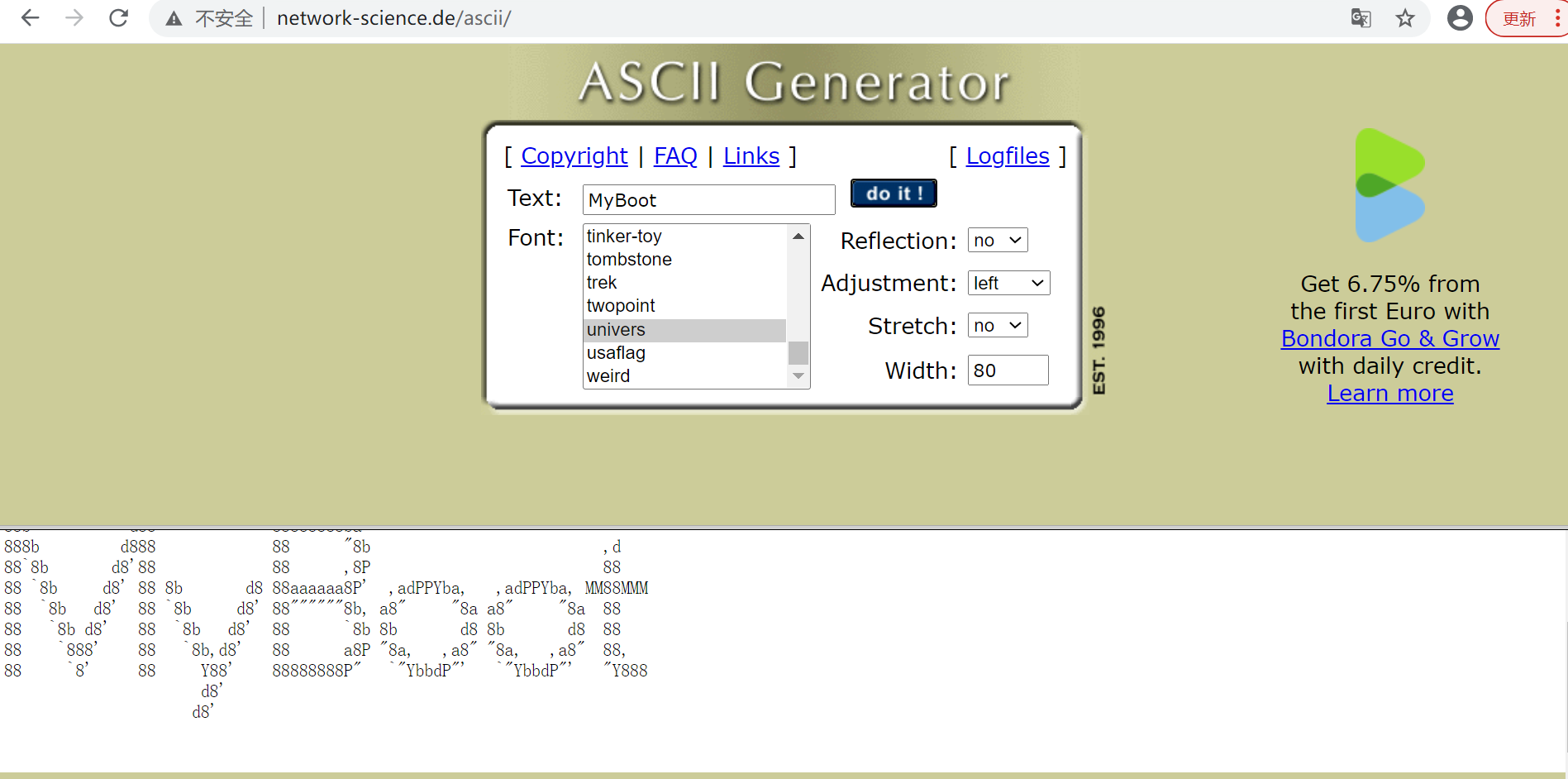
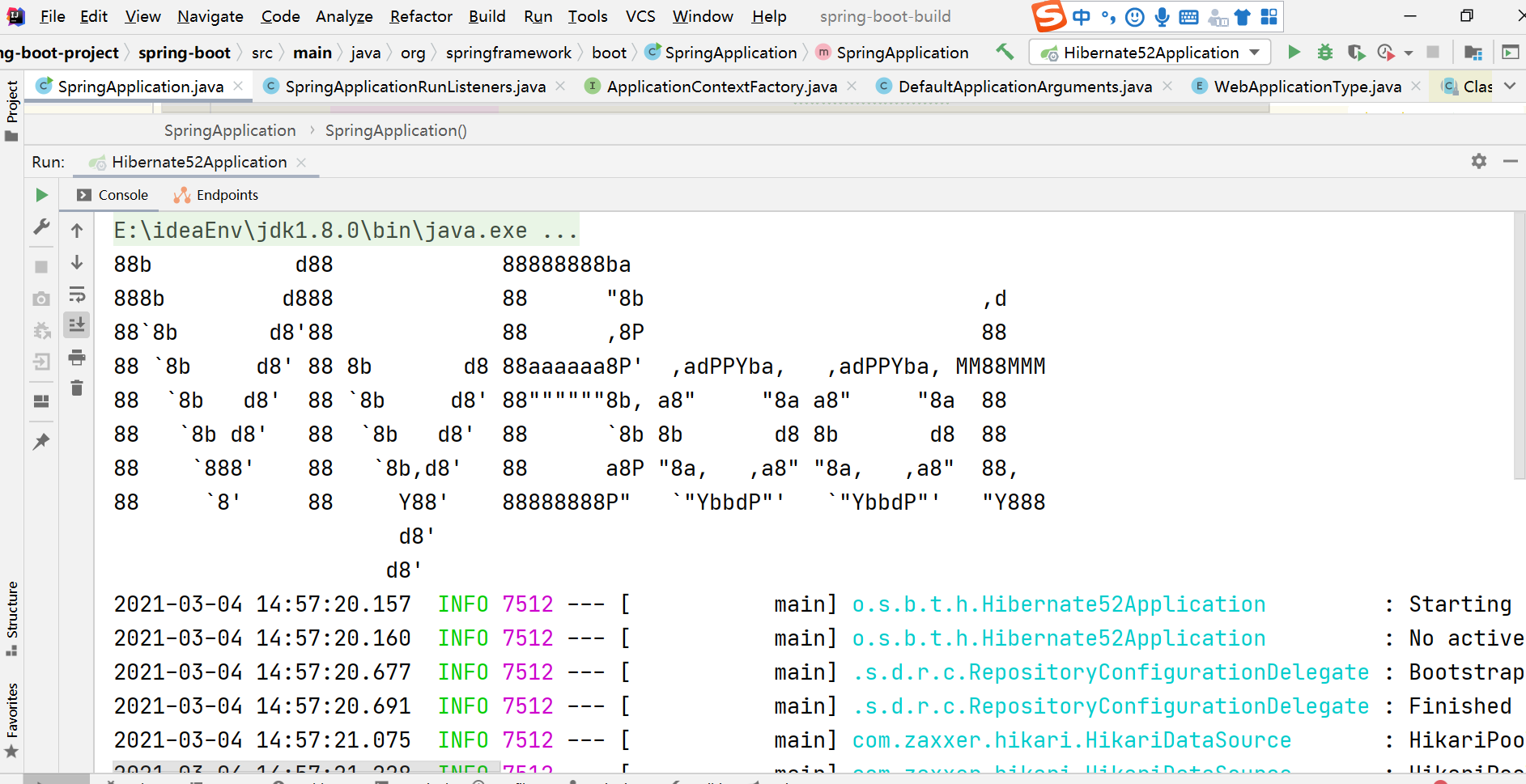
\spring-boot-tests\spring-boot-smoke-tests\spring-boot-smoke-test-hibernate52\src\main\resources
下创建banner.txt(注意:文件名称不能变,否则无法加载)
banner.txt内容如下
88b d88 88888888ba
888b d888 88 "8b ,d
88`8b d8'88 88 ,8P 88
88 `8b d8' 88 8b d8 88aaaaaa8P' ,adPPYba, ,adPPYba, MM88MMM
88 `8b d8' 88 `8b d8' 88""""""8b, a8" "8a a8" "8a 88
88 `8b d8' 88 `8b d8' 88 `8b 8b d8 8b d8 88
88 `888' 88 `8b,d8' 88 a8P "8a, ,a8" "8a, ,a8" 88,
88 `8' 88 Y88' 88888888P" `"YbbdP"' `"YbbdP"' "Y888
d8'
d8'
2.3 面试题
1、Spring Boot 的核心注解是哪个?它主要由哪几个注解组成的
启动类上面的注解是@SpringBootApplication,它也是 Spring Boot 的核心注解,主要组合包含了以下 3 个注解:
- @SpringBootConfiguration:组合了 @Configuration 注解,实现配置文件的功能。
- @EnableAutoConfiguration:打开自动配置的功能,也可以关闭某个自动配置的选项,如关闭数据源自动配置功能: @SpringBootApplication(exclude = { DataSourceAutoConfiguration.class })。
组合了
@AutoConfigurationPackage
@Import(AutoConfigurationImportSelector.class)
- @ComponentScan:Spring组件扫描
2、Spring Boot 自动配置原理是什么?
注解 @EnableAutoConfiguration, @Configuration, @ConditionalOnClass 就是自动配置的核心,
@EnableAutoConfiguration 给容器导入META-INF/spring.factories 里定义的自动配置类。
筛选有效的自动配置类。
每一个自动配置类结合对应的 xxx.java 读取配置文件进行自动配置功能
3、Spring Boot 中的 starter 到底是什么 ?
首先,这个 Starter 并非什么新的技术点,基本上还是基于 Spring 已有功能来实现的。首先它提供了一个自动化配置类,一般命名为 XXXAutoConfiguration ,在这个配置类中通过条件注解来决定一个配置是否生效(条件注解就是 Spring 中原本就有的),然后它还会提供一系列的默认配置,也允许开发者根据实际情况自定义相关配置,然后通过类型安全的属性注入将这些配置属性注入进来,新注入的属性会代替掉默认属性。正因为如此,很多第三方框架,我们只需要引入依赖就可以直接使用了。当然,开发者也可以自定义 Starter
4、运行 Spring Boot 有哪几种方式?
1)打包用命令或者放到容器中运行
2)用 Maven/ Gradle 插件运行
3)直接执行 main 方法运行
本文由
传智教育博学谷教研团队发布。如果本文对您有帮助,欢迎
关注和点赞;如果您有任何建议也可留言评论或私信,您的支持是我坚持创作的动力。转载请注明出处!
